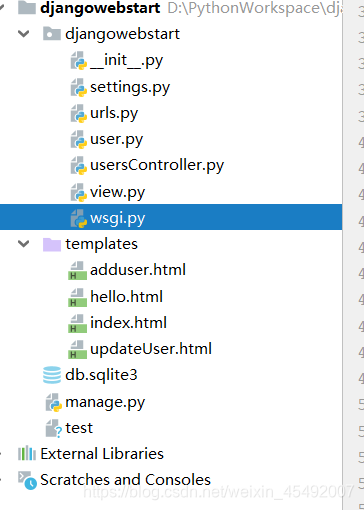1.前言
使用Django开发web应用的时候需要,先使用pip安装才可以使用
2.关于当前Django框架的结构理解

1.setting.py是web应用的基本设置,其中定义了使用的数据库以及认证模块(非常重要)
2.urls.py就是用于管理当前的访问的url对应的调用的模块所使用的方法

在使用当前的模块方法之前需要导入当前的模块:使用web路径为.
3.templates文件就是用于存放当前所需要的静态的html页面的
3.sqlite3数据展示

4.功能的基本展示
用户信息的列表展示

添加用户

修改用户

删除操作使用a标签实现
5.操作中遇到的问题
1.不能使用post请求的问题:解决在当前的form标签的下一行添加 {% csrf_token %}

2.重定向页面的问题:需要使用/结尾就可以了

6.web的基本操作
1.转发需要使用:from django.shortcuts import render
render(request, “updateUser.html”, model)
这里的第二个参数是html页面,model就是一个简单的dict字典数据
2.重定向需要使用:from django.shortcuts import redirect
redirect(to="…/users/") # 这里的user后面一定要加斜杠(/)
7.创建需要的user.py组件
class User:
def __init__(self, _id=None, _username=None, _password=None):
self.id = _id
self.username = _username
self.password = _password
8.创建usersController.py组件
from django.shortcuts import render
from django.shortcuts import redirect
import sqlite3
from .user import User # 如果是web环境需要通过from . 的方法是导入本地的模块类
def to_add_user_page(request):
print("访问当前的添加用户页面")
return render(request, "adduser.html")
# 重定向需要使用当前的redirect模块来实现定向操作、
def add_user(request):
request.encoding = 'utf-8'
if 'username' in request.POST and request.POST['username']:
username = request.POST["username"]
if 'password' in request.POST and request.POST['password']:
password = request.POST["password"]
if username and password:
print("当前添加的数据为:username:{0},password:{1}".format(username, password))
try:
conn = sqlite3.connect("db.sqlite3")
cursor = conn.cursor()
cursor.execute("insert into users(username,password) values(?,?)", (username, password))
conn.commit()
except Exception as e:
print("出现了错误:{0}".format(e))
finally:
close_database(cursor, conn)
print("执行添加用户信息操作")
else:
print("没有数据如何添加用户信息")
return redirect(to="../users/")
def to_update_user_page(request):
model = {}
if "id" in request.GET and request.GET["id"]:
id = request.GET["id"]
if id:
try:
conn = sqlite3.connect("db.sqlite3")
cursor = conn.cursor()
cursor.execute("select * from users where id=?", id)
user_data = cursor.fetchone()
model["updateUser"] = convert_to_user(user_data)
except Exception as e:
print("出现了错误:{0}".format(e))
finally:
close_database(cursor, conn)
else:
print("没有id如何执行查找操作!")
return render(request, "updateUser.html", model)
# 通过当前的id编号更新用户
def update_user(request):
if "id" in request.POST and request.POST['id']:
id = request.POST["id"]
username = request.POST["username"]
password = request.POST["password"]
try:
conn = sqlite3.connect("db.sqlite3")
cursor = conn.cursor()
cursor.execute("update users set username=? ,password=? where id=?", (username, password,
id))
conn.commit()
except Exception as e:
print("出现了错误:{0}".format(e))
finally:
close_database(cursor, conn)
else:
print("没有id如何更新?")
return redirect(to="../users/")
# 删除数据操作
def del_user_by_id(request):
if "id" in request.GET and request.GET['id']:
id = request.GET["id"]
try:
conn = sqlite3.connect("db.sqlite3")
cursor = conn.cursor()
cursor.execute("delete from users where id=?", id)
conn.commit()
except Exception as e:
print("出现了错误:{0}".format(e))
finally:
close_database(cursor, conn)
else:
print("没有id如何删除?")
return redirect(to="../users/")
# 用于向当前的数据库中查询所有的数据
def user_list(request):
print("访问当前的所有的用户信息数据")
try:
conn = sqlite3.connect("db.sqlite3")
cursor = conn.cursor()
cursor.execute("select * from users")
users = [convert_to_user(item) for item in cursor.fetchall()]
# 开始添加视图数据
model = {"users": users}
return render(request, "index.html", model)
except Exception as e:
print("出现异常:{0}".format(e))
finally:
close_database(cursor, conn)
# 用于将当前的数据库的数据转换称对应的用户信息对象
def convert_to_user(user_data=[]):
return User(user_data[0], user_data[1], user_data[2])
# 关闭数据库连接和关闭游标的操作
def close_database(cursor, conn):
if cursor in locals():
cursor.close()
if conn in locals():
conn.close()
9.其他的html页面
当前的页面放在templates文件中
1.index.html页面
<!DOCTYPE html>
<html lang="en">
<head>
<meta charset="UTF-8">
<title>用于管理界面</title>
</head>
<body>
<table border="1">
<tr>
<td colspan="4"><h1>欢迎使用用户管理系统</h1></td>
</tr>
<tr>
<td colspan="4"><a href="../toAddUserPage/">添加用户</a></td>
</tr>
<tr>
<th>用户编号</th>
<th>用户名</th>
<th>用户密码</th>
<th>操作</th>
</tr>
{% for user in users %}
<tr>
<td>{{ user.id }}</td>
<td>{{ user.username }}</td>
<td>{{ user.password }}</td>
<td><a href="../toUpdateUserPage?id={{ user.id }}">修改</a>
<a href="../delUser?id={{ user.id }}">刪除</a>
</td>
</tr>
{% endfor %}
</table>
</body>
</html>
2.当前的adduser.html页面
<!DOCTYPE html>
<html lang="en">
<head>
<meta charset="UTF-8">
<title>添加用户界面</title>
</head>
<body>
<form action="../addUser/" method="post">
{% csrf_token %}
<table border="1">
<tr>
<td colspan="2"><h1>添加用户操作</h1></td>
</tr>
<tr>
<td>用户名:</td>
<td><input type="text" name="username"/></td>
</tr>
<tr>
<td>用户密码:</td>
<td><input type="text" name="password"/></td>
</tr>
<tr>
<td colspan="2">
<input type="submit" value="保存"/>
<input type="button" value="返回" onclick="history.back()"/>
</td>
</tr>
</table>
</form>
</body>
</html>
3.当前的updateUser.html页面
<!DOCTYPE html>
<html lang="en">
<head>
<meta charset="UTF-8">
<title>添加用户界面</title>
</head>
<body>
<form action="../updateUser/" method="post">
{% csrf_token %}
<table border="1">
<tr>
<td colspan="2"><h1>修改用户操作</h1></td>
</tr>
<input type="hidden" name="id" value="{{ updateUser.id }}"/>
<tr>
<td>用户名:</td>
<td><input type="text" name="username" value="{{ updateUser.username }}"/></td>
</tr>
<tr>
<td>用户密码:</td>
<td><input type="text" name="password" value="{{ updateUser.password }}"/></td>
</tr>
<tr>
<td colspan="2">
<input type="submit" value="保存"/>
<input type="button" value="返回" onclick="history.back()"/>
</td>
</tr>
</table>
</form>
</body>
</html>
10.结果
测试成功,所有的跳转页面和添加修改删除查询数据都成功!这里不显示页面了
11.总结
1.在使用当前的Django中需要注意它的表达式{%%}
2.在重定向的时候一定要在路径的后面加斜杠
3.访问数据需要从当前的request.GET和request.POST中去取,这里数据集就是一个dict字典,需要先判断在取出数据
4.需要使用{{参数}}的方式显示dict中的数据,迭代需要使用{%for %}{%endfor%}
以上纯属个人见解,如有问题请联系本人!
